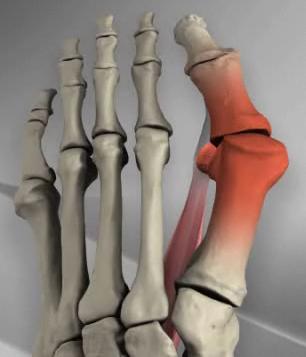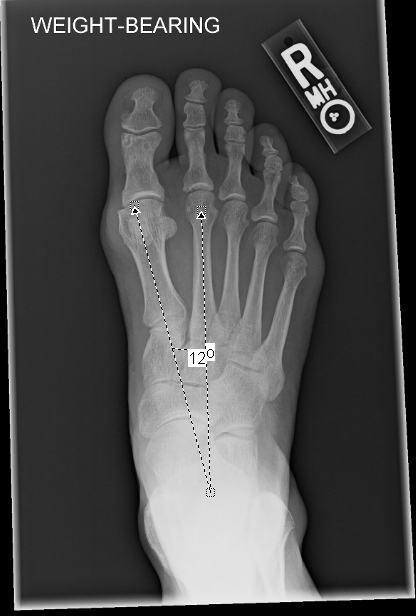Here at the Advanced Foot And Ankle Center we have many years of experience treating bunions. We perform the least invasive methods when possible, in order to help yopu to a quick recovery. We also put a large emphasis on aesthetically pleasing outcomes with minimal scarring, by using specialized plastic surgery techniques. Lastly we use modalities that keep pain to a minimum after the surgery. If you have a question about your bunions or bunion surgery feel free to send a picture and ask questions to the doctor by clicking here.

Bunion surgery generally involves an incision in the top or side of the big toe joint and the removal or realignment of soft tissue and bone to relieve pain and restore normal alignment to the joint of the big toe. If the joint is severely deformed, it may be stabilized with tiny wires, stitches, screws, or plates. There are no guarantees that a bunion surgery will fully relieve your pain.
- A regional anesthetic that affects only the foot is commonly used for bunion surgery. A sedative may also be used during the procedure.
- The procedure usually takes an hour or more, depending on the type of surgery.
- Bunion repairs are usually done on an outpatient basis.
There are over 75 surgeries for bunions. Studies do not indicate which type of surgery is best.The type of surgery performed needs to be specific to your deformity. Here we use digital technology to map out the deformity to aid in choosing the proper procedure for you.

The general types of bunion surgery are:
- Removal of part of the metatarsal head (the part of the foot that is bulging out). This procedure is called exostectomy or bunionectomy.
- Realignment of the soft tissues (ligaments) around the big toe joint.
- Removal of a small wedge of bone from the foot (metatarsal osteotomy) or from the toe (phalangeal osteotomy).
- Removal of bone from the end of the first metatarsal bone, which joins with the base of the big toe (metatarsophalangeal joint). At the metatarsophalangeal joint, both the big toe and metatarsal bones are reshaped (resection arthroplasty).
- Fusion (arthrodesis) of the big toe joint.
- Fusion of the joint where the metatarsal bone joins the mid-foot (Lapidus procedure).
- Implant insertion of all or part of an artificial joint.
- To the right is a patient at our center who greatly increased his range of motion after bunion surgery
What To Expect After Surgery
The usual recovery period after bunion surgery is 6 weeks to 6 months, depending on the amount of soft tissue and bone affected. Complete healing may take as long as 1 year.
- When you are showering or bathing, the foot must be kept covered to keep the incision dry.
- At our center we bury the stitches under the skin using absorbable stitches so that you don’t have to have them pulled out.
- Walking casts, splints, special shoes, or wooden shoes are sometimes used. Regular shoes can sometimes be worn in about 4 to 5 weeks, but most procedures require wearing special shoes up to 8 to 12 weeks after surgery. Many activities can be resumed in about 6 to 8 weeks.
- After some procedures, no weight can be put on the foot for 6 to 8 weeks. Then there are a few more weeks of partial weight-bearing with the foot in a special shoe or boot to keep the bones and soft tissues steady as they heal.
Why do bunion surgery
You may want to consider surgery when:
- Nonsurgical treatment has not relieved your bunion pain.
- You have difficulty walking or doing normal daily activities.
After surgery, your ability to walk and do other activities is likely to improve. The big toe joint is generally less painful and, as a result, moves better. After the incision has healed and the swelling has gone down, the toe may look more normal than before.
Risks
Risks of surgery include:
- Infection in the soft tissue or bone of the foot.
- Side effects from anesthetic medicines or other medicines used to control pain and swelling.
- Recurrence of the bunion.
- An outward or upward bend in the big toe.
- Decreased feeling or sensation, numbness or tingling, or burning in the toe from damage to nerves.
- Damage to the tendons that pull the big toe up or down.
- A shorter big toe, if bone is removed.
- Restricted movement or stiffness of the big toe joint (may be an expected outcome of some types of surgery).
- Persistent pain and swelling.
- Degenerative joint disease (arthritis) or avascular necrosis (disruption of the blood supply to the bone) after surgery.
- Development of a callus on the bottom of the foot.
What To Consider
Consider the following when deciding about bunion surgery:
- Bunions may return after surgery, especially if you continue to wear narrow or high-heeled shoes.
- The type of surgery used depends on the severity of the bunion and the surgeon’s experience. Each bunion is different, and surgery needs to be tailored to each case.
- Your expectations may influence your satisfaction with the surgery.
- You will have to stay off your foot for a while after surgery.
SURGICAL OUTCOMES AND RESULTS FROM THE ADVANCED FOOT AND ANKLE CENTER OF SAN DIEGO
There is more to bunion surgery than getting rid of the bump. Below you will see many of our statistics over the last 5 years showing minimal to no pain after the surgery and speed of return to activities.The scores seen below are averaged from the procedures done that year
| 2007 | 2008 | 2009 | 2010 | 2011 | |
|---|---|---|---|---|---|
| Return to shoes including flip flops and High Heels | 100% | 100% | 100% | 100% | 100% |
| Patient overall satisfaction | 97 | 98 | 97 | 99 | 99 |
| Post operative pain tolerability | 1.5 | 1.7 | 1.5 | 1.4 | 1.4 |
| Return to full activities | 5.8 | 5.8 | 5.7 | 5.8 | 5.8 |
Patient satisfaction was measured by overall satisfaction with the experience and would they have the procedure done again. It was done using a point system of 0-100. 0 was non satisfied 100 fully satisfied.
Post operative pain tolerability was measured by a modified visual pain analog scale , and by the amount of pain medicine used. 0 was no pain 10 was unbearable pain.
Return to full activities was measured by an average of the amount of weeks it took to get back to full activities.
Return to shoes was measured by the ability to wear shoes including high heels for long periods of time
